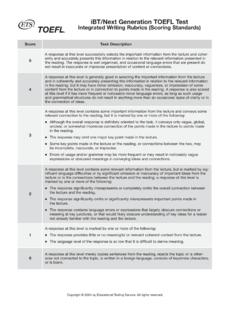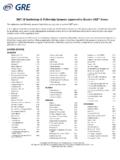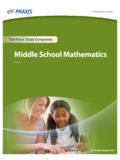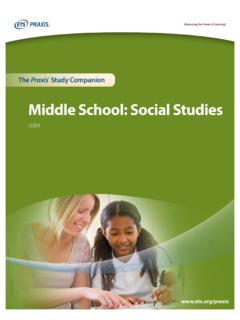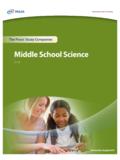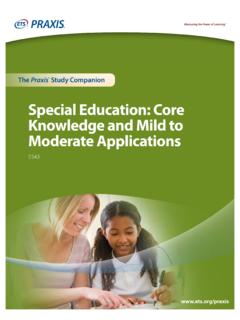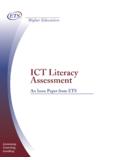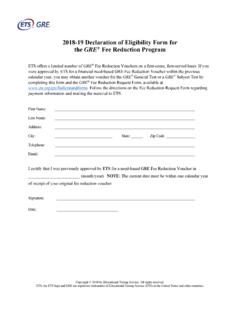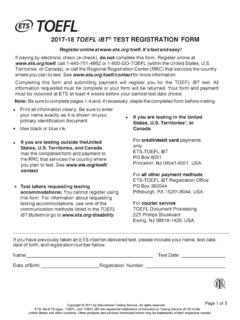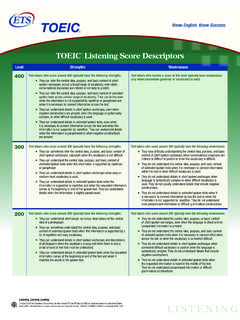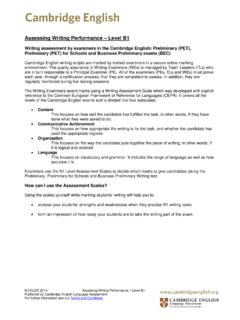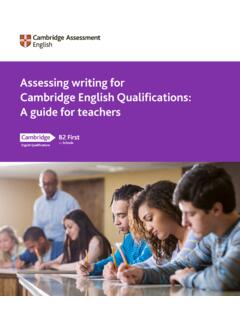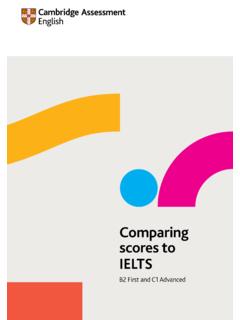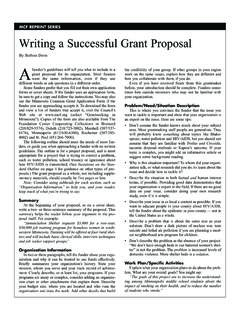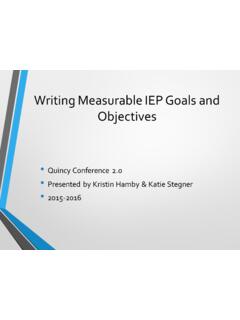Transcription of Linking TOEFL IBT scores to IELTS scores
1 Linking TOEFL iBT scores to IELTS scores A Research ReportETSD ecember 17, 2010 Linking TOEFL iBT scores to IELTS scores A Research Report 1 Abstract TOEFL test scores have been widely accepted as evidence of nonnative English speakers proficiency in the use of English. The TOEFL test measures test takers ability to communicate in English medium colleges and universities. The TOEFL iBT test measures a candidate s ability to combine listening, reading, speaking and writing skills with authentic and innovative integrated tasks, making it the most comprehensive English language proficiency test. Accepted by over 7,500 score users in more than 130 countries, the TOEFL test is the most widely recognized English language test in the world. Recently, ETS conducted score comparison research between the TOEFL test and an alternative test, IELTS (International English Language Testing System).
2 For the research, ETS obtained a sample of 1,153 students who had both IELTS and TOEFL scores . Using equipercentile Linking , the corresponding TOEFL score that would pass the same percentage of test takers for each IELTS scores was obtained. The score comparison results for each section (Listening, Speaking, Reading, and writing ) and the total test showed that most of the students scored in the middle to mid high score ranges on both tests. Limitations of the research and suggestions for future research are also discussed. Linking TOEFL iBT scores to IELTS scores A Research Report 2 Linking TOEFL iBT scores to IELTS scores Introduction TOEFL test scores have been widely accepted by educational and other institutions throughout the world as evidence of nonnative English speakers proficiency in English language use, and the TOEFL test has received very positive feedback from score users and instructors in the English as a Second Language (ESL) community.
3 There are many occasions when scores from different tests or even from different versions of the same test need to be linked for decision making or other purposes. For example, the scores on the SAT I and ACT tests, two well known college admissions tests in the United States, have been linked to each other to help university admissions offices use the scores to evaluate applicants. A research study was carried out by both ETS and ACT research staff to develop a score comparison table for this purpose (Pommerich, Hanson, Harris, & Sconing, 2000.) Another example is that, when the TOEFL iBT test, was developed to be taken via the Internet and to replace the computer adaptive test (cBT) version, a study was conducted to link TOEFL iBT scores to TOEFL cBT scores (Wang, Eignor, & Enright, 2007.) Recently, ETS conducted score comparison research between the TOEFL test and an alternative test, IELTS (International English Language Testing System).
4 As a best practice required by the Guidelines for Practice by the International Language Testing Association (ILTA, 2007), the Standards for Educational and Psychological Testing (AERA, APA, NCME, 1999), and the ETS standards (ETS, 2002, p. 45,), appropriate psychometric procedures should always be used to link scores from two different assessments if the scores are to be compared. To comply with this standard, ETS psychometric staff conducted a research study to explore and establish empirical relationships between the scores on the two tests. This research was designed and carried out to answer the following two research questions: 1. What TOEFL iBT section scores are comparable to IELTS section scores ? 2. What TOEFL iBT total scores are comparable to IELTS total scores ? Linking TOEFL iBT scores to IELTS scores A Research Report 3 Finding the corresponding TOEFL iBT scores for each of the IELTS scores was accomplished by what is known as score Linking or score comparison (called score comparison hereafter in this report) in the field of educational measurement.
5 In this report, the samples and the analyses will be described in the Method section. The section for Results will present score comparisons for the four skill sections and the total scores . This is followed by the Discussion section that considers the interpretation of the results and their implications in terms of the generalization of the findings from this study, evaluates the limitations of the research, and makes suggestions for future research. Linking TOEFL iBT scores to IELTS scores A Research Report 4 Method Data Collection In order to acquire empirical evidence for Linking the scores on the two tests, scores were obtained from students who had taken both tests (Pommerich, 2007). The data collection effort for this research started in 2008 and continued into 2009. The first batch of data, obtained in 2008, contained 217 students who submitted to ETS copies of their TOEFL and IELTS score reports.
6 In order to increase the sample size and the stability of the results, ETS then contacted a large number of test takers via e mail and encouraged the participants to submit their latest scores on both tests to ETS. Over 1,000 students responded and reported their scores on the two tests to ETS. The two batches of data were then combined for the study. Before any analyses started, the first task was to clean the data, which involved removing unusable records. Records that had missing scores on one or more sections or that had invalid scores were removed from subsequent analyses. For example, one reported IELTS score of was identified as an invalid score and was eliminated from the analysis data set1. After this data cleaning procedure, 1,153 records were retained for the analyses described in the next section. Close to 1,000 records included the participants country of testing information, including about 70 countries from around the world.
7 The largest group was from China including Hong Kong (41%), followed by USA (6%), and Japan (5%). The others were all below 4%. Data Analysis To understand the statistical characteristics of the scores on the two tests from the final sample of 1,153 students and to establish the relationships between the scores on the two tests, the following types of analysis were conducted. The findings from the analyses are presented in the Results section. 1. Descriptive statistics were computed to evaluate such information as the average scores on each test at both the section and the total score level, and how much variation (standard deviation) was observed in the scores . The correlation between the scores on the two tests was also computed to see to what extent the scores on the two tests were related to each other. 1 IELTS scores have 9 bands in one half increments ( , 3, , 4, ) Linking TOEFL iBT scores to IELTS scores A Research Report 5 2.
8 Linking scores is basically a transformation from a score on one scale to a score on the other scale (Holland, 2007) and can be accomplished in a variety of ways depending on the nature of the data and the purpose of the Linking (Kolen & Brennan, 1995; Holland & Dorans, 2006). To find the correspondence between the TOEFL iBT and IELTS tests for each section and for the total score , ETS psychometric staff conducted extensive analyses between March and August 2009 using a variety of statistical methods including regression based prediction, conditional probability based score matching, and equipercentile Linking . In reviewing the results and in consideration of the purpose of this research, we deemed it most appropriate to use the equipercentile Linking method. This approach has been used extensively in a variety of settings ( the Linking of the SAT test with the ACT test) and allowed us to identify the corresponding TOEFL iBT scores which would restrict/pass a similar percentage of the students in the sample as would the IELTS scores .
9 Given the need for both tests to screen out applicants in a comparable manner, we believe this to be the most defensible and straightforward approach. Results Descriptive Statistics of the Sample TOEFL iBT scores range from 0 to 30 for each section and 0 to 120 for the total test; the total test score is the sum of the four sections. IELTS reports both section and total scores on a 9 band scale in one half ( ) band increments; the total test score is the average of the four sections. This general information about the different score scales of the two tests can help put the scores of the research sample in perspective. For example, because of the compact IELTS score scales, IELTS scales will show much smaller score variation (standard deviation values in Table 1) than the TOEFL iBT scales. Also, for some IELTS scores in Tables 3 to 7, the corresponding TOEFL iBT scores will show score ranges due to the larger TOEFL scales.
10 Table 1 gives the sample size, the mean scores , and the score variations (standard deviation, score range) of the two tests. On IELTS , the Reading and Listening mean scores were both , and the Speaking and writing means were and , respectively. The total test mean score was On the TOEFL iBT scale, the Reading and Listening mean scores were both close to 21 and the Speaking and writing mean scores were 20 and , respectively. The total mean score was To evaluate the overall performance of the students in this research sample, the 2009 test performance information on the two tests was obtained from the respective websites and is presented in the column for 2009 population mean in Table 1. Linking TOEFL iBT scores to IELTS scores A Research Report 6 Generally speaking, the students in this sample, as a group, scored higher on both tests than their respective populations did in 2009.
